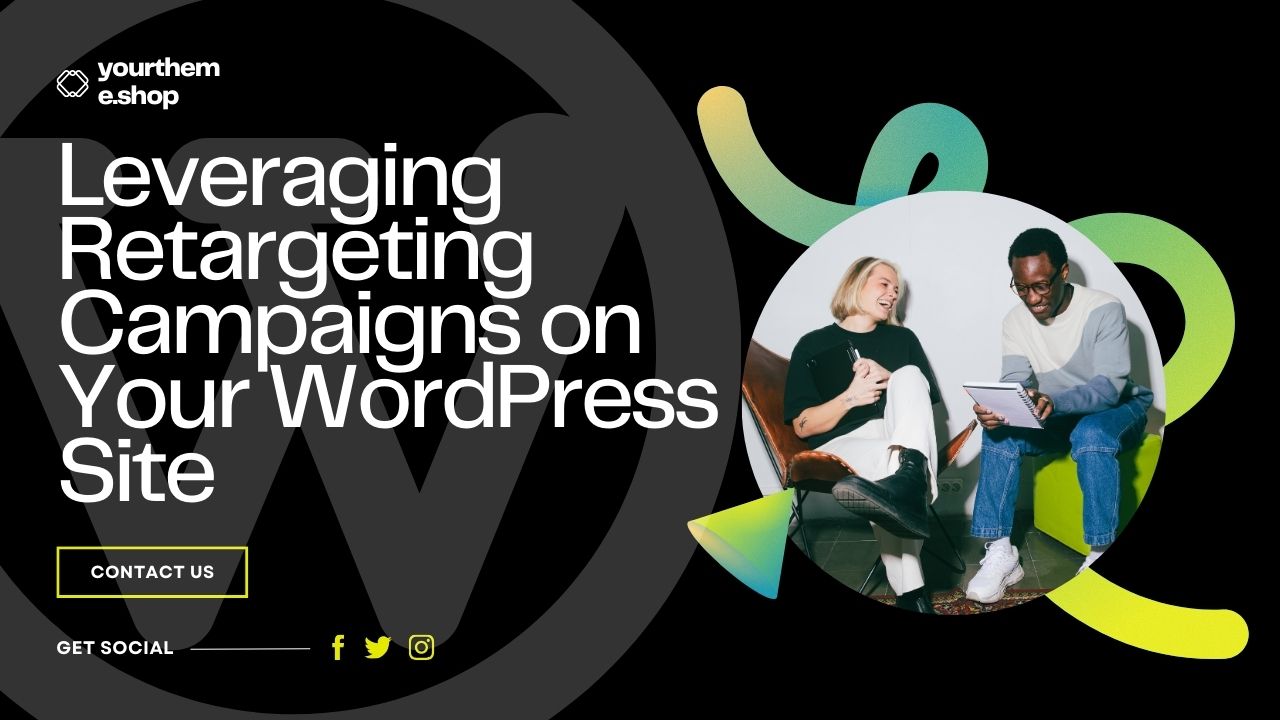In today’s digital marketing landscape, leveraging retargeting campaigns on your WordPress site is a game-changer. As an experienced SEO and copywriter, I understand the intricacies of retargeting and its impact on conversions and user engagement. This comprehensive guide will explore the strategies and insights necessary for setting up successful retargeting campaigns on WordPress, ensuring your site not only attracts visitors but also effectively brings them back.
Leveraging Retargeting Campaigns on Your WordPress Site
Setting Up Retargeting Campaigns on WordPress
Choosing the Right Retargeting Tools and Plugins
The first step in implementing retargeting campaigns on WordPress is selecting the appropriate tools and plugins. Options like Google Remarketing and AdRoll offer robust functionalities for tracking and retargeting visitors.
How to Set Up Retargeting Campaigns on WordPress: A Step-by-Step Guide
Setting up a retargeting campaign involves integrating tracking pixels into your WordPress site, defining your target audience, and creating compelling ad creatives that resonate with your visitors.
Crafting Effective Retargeting Ads
Designing Engaging Retargeting Ads
Crafting Visually Appealing Retargeting Creatives
In the realm of digital marketing, particularly when leveraging retargeting campaigns on your WordPress site, the visual appeal of your ads plays a pivotal role. A well-designed ad not only captures attention but also reinforces brand recognition.
Elements of a Visually Engaging Ad
- Color Scheme and Imagery: Utilize colors and images that align with your brand and resonate with your target audience.
- Consistent Branding: Ensure your ads reflect your brand’s style and ethos for immediate recognition.
Conveying Clear Messaging in Retargeting Ads
The messaging in your retargeting ads should be concise and targeted. It’s about reminding visitors of their initial interest and nudging them towards taking action.
Crafting Compelling Ad Copy
- Highlighting Benefits: Focus on the benefits that resonated with the visitor initially.
- Call-to-Action: Use a strong call-to-action that aligns with the visitor’s previous interaction on your site.
Optimizing Retargeting Strategies for WordPress Sites
Aligning Ads with User Intent
For optimizing retargeting strategies for WordPress sites, align your ads with the specific interests and behaviors of your visitors. This personalized approach significantly increases the likelihood of conversion.
Personalization Techniques
- Behavioral Targeting: Create ads based on the specific pages or products the visitor showed interest in.
- Dynamic Content: Use dynamic content in ads to personalize them based on user interaction.
Testing and Refining Retargeting Ads
Continuously test different elements of your ads, such as imagery, copy, and call-to-action, to determine what resonates best with your audience. Use A/B testing to refine your approach.
A/B Testing for Enhanced Performance
- Experiment with Variations: Test different versions of your ads to see which elements perform best.
- Analyzing Results: Use analytics to measure the performance of each variation and make data-driven decisions.
Increasing Conversions with Retargeting on Your WordPress Site
Strategies for Higher Conversion Rates
To increase conversions with retargeting on your WordPress site, focus on creating ads that directly address the reasons why visitors didn’t convert during their initial visit.
Conversion-Focused Tactics
- Offer Incentives: Use special offers or discounts in your ads to entice visitors to return and complete a purchase.
- Urgency and Scarcity: Incorporate elements of urgency or scarcity, like limited-time offers, to encourage quick action.
Integrating Retargeting with Overall Marketing Efforts
Ensure that your retargeting campaigns are part of a cohesive marketing strategy. This integration helps in creating a seamless experience for your visitors across different touchpoints.
Synergizing with Other Channels
- Email and Social Media: Coordinate your retargeting ads with your email marketing and social media efforts for a unified marketing message.
- Content Marketing: Align your retargeting ads with the content strategy of your WordPress site to reinforce the messaging.
Optimizing Retargeting Strategies for WordPress Sites
Optimize your retargeting strategies by segmenting your audience based on their behavior and tailoring your ads to align with their interests. This targeted approach increases the likelihood of conversion.
Analyzing and Refining Your Retargeting Strategy
Measuring the Success of Retargeting Campaigns
The Importance of Analytics in Retargeting
In the realm of digital marketing, particularly when leveraging retargeting campaigns on your WordPress site, the importance of measuring campaign success cannot be overstated. This process is crucial for understanding the effectiveness of your retargeting efforts and for optimizing future campaigns.
Key Metrics for Evaluating Retargeting Campaigns
To effectively measure the success of your retargeting campaigns, several key metrics need to be analyzed. Each metric offers a unique insight into the performance and impact of your retargeting strategies.
Click-Through Rates (CTR)
- Understanding CTR: CTR is a critical metric that measures the percentage of users who click on your retargeted ads. A high CTR indicates that your ads are relevant and engaging to your audience.
- Optimizing for Higher CTR: To optimize your CTR, focus on creating compelling ad copy and visually appealing designs that resonate with your target audience.
Conversion Rates
- Measuring Conversion Success: Conversion rates track the percentage of users who take the desired action after clicking on your retargeted ads. This could include making a purchase, signing up for a newsletter, or filling out a contact form.
- Strategies for Improving Conversion Rates: Enhance your conversion rates by ensuring that your landing pages are optimized for conversions and that your ad messaging aligns with the landing page content.
Return on Ad Spend (ROAS)
- Calculating ROAS: ROAS measures the financial return of your retargeting campaigns relative to the amount spent on ads. It’s a vital metric for understanding the profitability of your retargeting efforts.
- Maximizing ROAS: To maximize ROAS, focus on targeting highly engaged users and refining your ad targeting to reduce wasted ad spend.
Optimizing Retargeting Strategies for WordPress Sites
Utilizing Data for Campaign Optimization
The data gathered from tracking these metrics is invaluable for optimizing retargeting strategies for WordPress sites. By analyzing this data, you can make informed decisions to enhance the effectiveness of your campaigns.
Continuous Improvement and Adaptation
- Adapting Campaigns Based on Performance: Regularly review your campaign performance and make necessary adjustments to targeting, ad creative, and budget allocation based on the insights gained.
- A/B Testing for Optimal Results: Implement A/B testing to compare different ad variations and determine which elements resonate best with your audience.
Increasing Conversions with Retargeting on Your WordPress Site
To increase conversions with retargeting on your WordPress site, leverage the insights gained from your campaign analytics. Focus on refining your ad targeting, improving ad creatives, and optimizing the user journey to maximize conversion opportunities.
Refining Strategies for Increased Conversions
Based on the data gathered, refine your retargeting strategies to enhance their effectiveness. Experiment with different ad formats, messaging, and targeting criteria to find the optimal combination for your WordPress site.
Advanced Retargeting Techniques for WordPress
Exploring Advanced Retargeting Options
Embracing Dynamic Retargeting Techniques
In the realm of digital marketing, leveraging retargeting campaigns on your WordPress site involves more than just basic strategies. Advanced techniques, particularly dynamic retargeting, play a crucial role in enhancing the effectiveness of your campaigns.
Personalization: The Core of Dynamic Retargeting
Dynamic retargeting takes personalization to the next level. It involves creating ads that are tailored based on the specific products or content viewed by the visitor. This approach significantly increases the relevance of your ads, making them more appealing to your audience.
Tailoring Ads to User Interests
- Customized Product Recommendations: Implement systems that track user interactions with products and display ads featuring those specific items.
- Content-Specific Targeting: Use visitor data to showcase ads related to the content they engaged with on your site.
Increasing Conversions with Retargeting on Your WordPress Site
Dynamic retargeting is instrumental in increasing conversions. By presenting users with ads that reflect their specific interests and previous interactions with your site, you significantly enhance the chances of converting their interest into action.
Strategies for Conversion Optimization
- Segmentation and Targeting: Segment your audience based on their behavior and preferences, and target them with highly relevant ads.
- Continuous Optimization: Regularly analyze the performance of your dynamic retargeting ads and optimize them for better results.
Advanced Techniques in Retargeting Campaigns
Leveraging AI for Enhanced Personalization
Artificial Intelligence (AI) can take dynamic retargeting to new heights. By leveraging AI algorithms, you can predict user preferences and display ads that are most likely to resonate with individual users.
AI-Driven Retargeting Strategies
- Predictive Analytics: Use AI to analyze past user behavior and predict future interests, tailoring your retargeting campaigns accordingly.
- Automated Ad Optimization: Implement AI tools that automatically optimize your ad creatives and targeting based on ongoing user data.
How to Set Up Retargeting Campaigns on WordPress with Advanced Tools
Setting up advanced retargeting campaigns on WordPress requires integrating sophisticated tools and plugins that support dynamic and AI-driven retargeting functionalities.
Integration and Implementation
- Choosing Advanced Retargeting Tools: Select tools and plugins that offer dynamic and AI-driven retargeting capabilities.
- Implementation Process: Follow a detailed process to integrate these tools into your WordPress site, ensuring they accurately track and analyze user behavior.
Increasing Conversions with Retargeting on Your WordPress Site
To increase conversions, leverage advanced retargeting techniques that focus on visitors who have shown a high level of interest in your products or services but have not yet converted.
Integrating Retargeting with Overall Marketing Strategy
Aligning Retargeting with Your Marketing Goals
Ensure that your retargeting efforts are aligned with your overall marketing goals. Retargeting should be a part of a comprehensive marketing strategy that includes SEO, content marketing, and other digital marketing efforts.
Synergizing Retargeting with Other Marketing Efforts
Integrate your retargeting campaigns with other marketing channels like email marketing, social media, and content marketing to create a cohesive and unified user experience.
Elevate your WordPress site’s success with strategic retargeting. From crafting compelling ads to advanced techniques like dynamic retargeting and AI-driven strategies, optimize conversions. Align with overall marketing goals for a cohesive and effective user experience. Elevate your digital marketing game!



